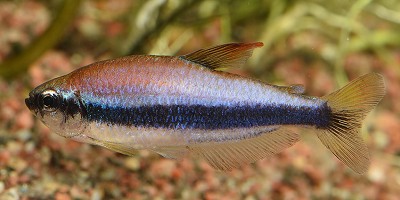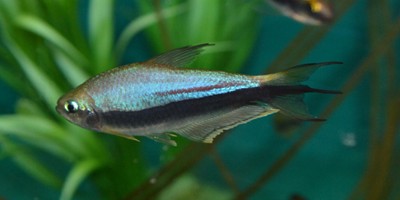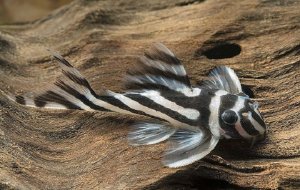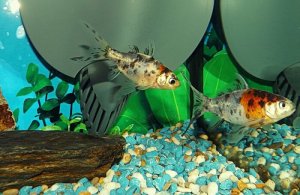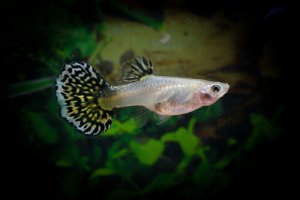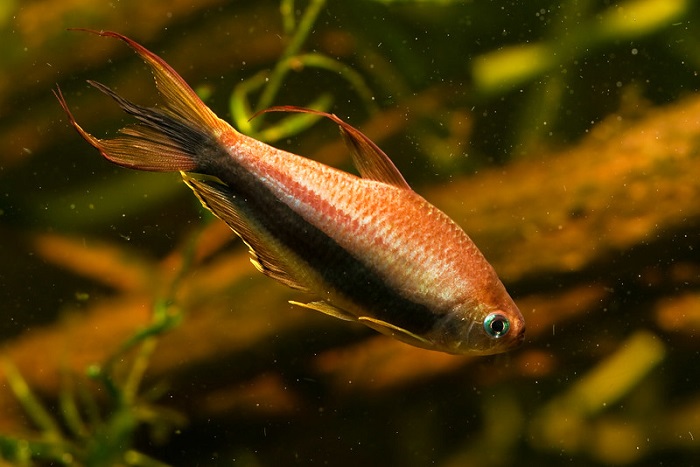
Most likely one of the most attractive and unappreciated Tetra species is the Emperor Tetra. With its small but intricate details such as the yellow and red ridges on the fins, metallic color eyes, and soft hues of blue and purple, along with the prominent black stripe, the Emperor Tetra can look quite spectacular in a dimly lighted tank, with darker décor, and as this is their preferred living environment, you have the perfect match.
In behavior they are placid and calm, getting along well with most other fish species, though the males are quite territorial.
If anything the Emperor Tetra is not your average, everyday freshwater fish, and there are so many interesting facts that I have found out about them, so with no delay, let me tell you more.
Emperor Tetra Breed Overview
| Origin | Columbia |
| Lifespan | 5-7 Years |
| Size | 10. 6 cm (4.2 Inches) |
| Colors | Blue, Purple, Rainbow, Black |
| Food | Omnivores |
| Tank Size | 15 – 30 Gallons |
| Temperament | Peaceful, Placid, Anxious |
| Water Type | Freshwater |
| Water Temperature | 23–27 °C (73,4°F – 80,6°F) |
| Water pH | 5.5 – 6.0 |
| Difficulty Level | Intermediate |
Species Information
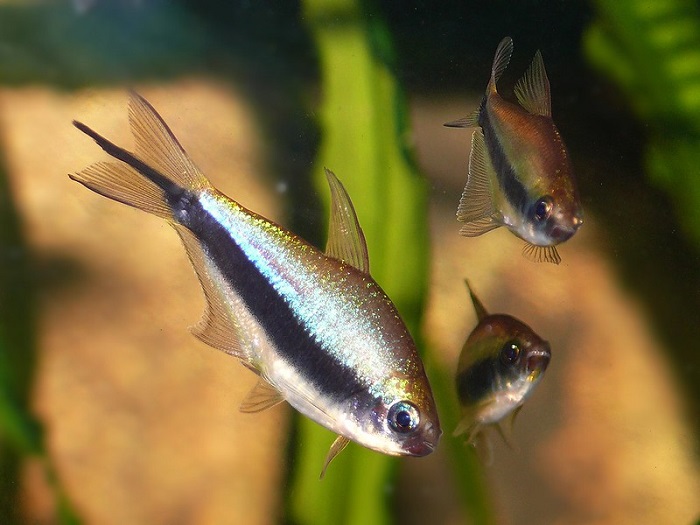
The Emperor Tetra “Nematobrycon palmeri” forms part of the Characid fish family, and is a well-known freshwater Tetra species that is mostly found in Western Columbia, in the Atrato and San Juan Basins and rivers. Since the species was first imported into the United States in 1960 it became a well-known Tetra Species in the pet trade among many avid aquarists.
Be mindful though, not to confuse the Emperor Tetra, with the Royal Tetra “Inpaichthys Kerri”, which closely resembles the Emperor Tetra, however, that is an entirely different species. I have included a table to show you the subtle differences between the two species.
|
Royal Tetra
|
Emperor Tetra
|
Color Variations In The Emperor Tetra
Quite an interesting factor about the Emperor Tetra is its color irregularities, meaning they have a similar base color, with different stripe color ranges. Your typical Emperor Tetra will have an elongated shape with a high back and an elongated dorsal fin that will have darker edges on the fringes. You may notice that the other fins similarly display dark fringes, though they have a yellow color.
The back of the fish will be an olive-brown color, and there is a broad iridescent stripe that runs from the eye to the base of the tail along the sides. What is interesting enough, is that this stripe can range in color from yellow, and green, to blue, violet purple, and sometimes even black. You will also see that below the colorful stripe, there will be a broad black band.
In the Emperor Tetra especially there is no adipose fin, contrary to the Royal Tetra.
Males And Females – As with most ornamental fish species, the male will have more striking colors, and longer fins than the females, yet they also have a taller body. One of the best ways to tell whether your Emperor Tetra is male or female is to look at the eyes. Males have Metallic Blue Eyes, and females have Metallic Green Eyes. The Male will have a tail with three prongs and a black stripe that extends well into the tail, while females will have the black stripe reaching only up to the translucent area of their tail.
Other Variations
- Black Emperor Tetra – The Black Emperor Tetra identified as Another “Nematobrycon Palmeri”, is no longer a species on its own, but rather a subspecies of the Emperor Tetra that has gray and black colors.
- Blue Emperor Tetra – The Blue Emperor Tetra is like the original Emperor Tetra, though not the same Scientific species, as it possesses an adipose fin. It is from the “Inpaichthys kerri” family and has a metallic blue back with a subdued black band across the side of the body.
- Purple Emperor Tetra – Similarly the Purple Emperor Tetra is from the “Inpaichthys kerri” family, boasting a bright Purple blue color and a dark purple, almost black line that runs across the body. They have translucent fins that have tinges of red and yellow. Remarkably, the Purple Emperor Tera possesses an adipose fin in both sexes.
- Rainbow Emperor Tetra – The Rainbow Emperor Tetra is truly a remarkable specimen from this species that has iridescent scales bouncing off rainbow colors, with a darker colored line stretching from the tailfin to the eye. The Rainbow Tetra is a “Nematobrycon lacortei” species, and very much on the rare side in the pet trade.
Size And Lifespan
Your average Emperor Tetra can grow to an adult size of around 10. 6 cm (4.2 Inches). With proper care most Emperor Tetras will live between 5-6 years, however, there have been cases where they have lived for up to 7 years.
Emperor Tetra Temperament And Behavior
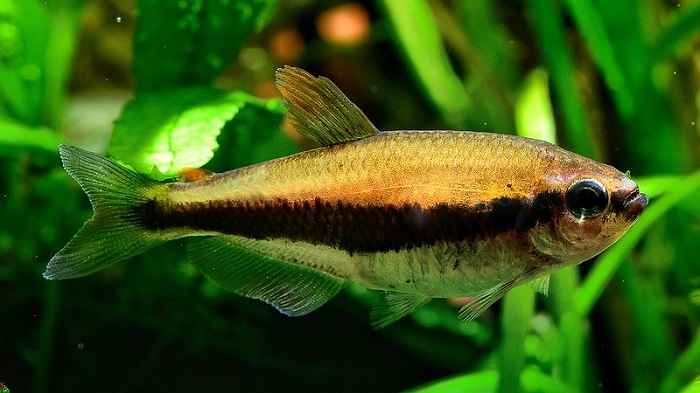
The Emperor Tetra has quite a unique temperament and behavioral pattern. They are Shoaling fish, though not as eager as other Tetra species, thus they can quite happily be kept in a pair with a male or a female. Important to remember though, Emperor Tetra males are aggressive towards each other, so if you are planning on keeping a group, there should be a single male, with females.
The Emperor Tetra is referred to as placid, and peaceful, and does not enjoy the company of aggressive and boisterous other species. When it comes to tank mates, they can be on the fussy side.
If you keep a larger group of Emperor Tetra, with one male only, or a pair with a male and female, you are on the safe side with them, and in this case with most other species tank mates.
General Care
Tetras in general can become very apprehensive in an aquarium environment that is not suitable, or comfortable for them, meaning that experience and effort, with the right knowledge of their care is crucial for their well-being and that of the rest of your tank mates, should you be keeping them in a community aquarium.
First of all, we want to create a living space for them that is tranquil and provides them with all their specific requirements for them to thrive;
Aquarium Set-Up
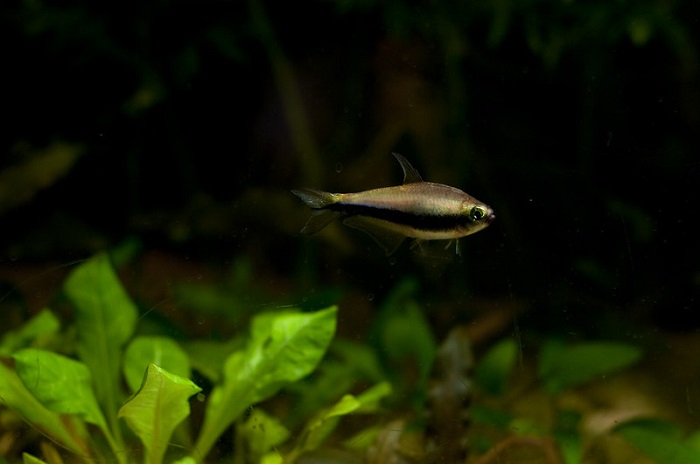
I like to start with the natural habitat of the Emperor Tetra, which is slow-moving rivers, streams, and black waters in River basins in West and Southwest Columbia.
The waters are moderately soft, clean, slightly acidic, and warm in these areas. There is dense vegetation, and most Tetra species prefer shaded areas and dim light. Most Tetras need ample swimming space, a few hiding spots, and plenty of plants, so, on that note, let’s start building our perfect aquarium for the Emperor Tetras.
- Tank Size – If you are going to keep only a pair of Emperor Tetras, maybe with an additional small bottom feeder fish, you can get away with a 10-gallon tank. Though for a community tank with a group of six or more Tetras, and other species, I highly advise a tank of at least 20-30 gallons.
- Water Conditions – Emperor Tetras prefers slightly acidic, soft water with a pH of between 5.5 and 6.0 and water hardness of around 3-6 dKH. Temperatures between 23–27 °C (73,4°F – 80,6°F) need to be kept, as they enjoy cool to warmer water conditions. Interesting fact; Cardinal Tetras or the “palmeri” species found in Blackwater rivers have a very high tolerance for sulfuric acid and low water pH, and most Tetras can withstand an immediate transfer, for an indefinite period in waters of a pH3.5 ratio. Though, please note this is not what we are aiming for in our tank.
- Filtration – As Emerald Tetras enjoy slow-moving water, and do not generate an exorbitant amount of waste, for two to four Tetras you could easily get away with a sponge filter. However, in larger community tanks a Hang On Back filter or canister filter should be more suitable.
- Heater – As you have noted from the Water Conditions, the Emperor Tetra enjoys warmer water, and thus a submersible or In-Line heater is needed, along with a reliable thermometer to keep water temperatures at optimal levels.
- Light – As with most other Tetra species, the Emperor Tetra enjoys more subdued light and shade. You can create this with the use of long-stem plants, floating plants, caves, hiding spots, and darker substrates. A dim tank light can be used to just give a clearer indication of night and day, and keep in mind for live plants some natural light will be needed for growth
Decorating Your Tank
For Your Emperor Tank decoration, I would recommend something more suited to their natural habitat, as they can get anxious at times, though the decorative part will be your personal preference.
Darker colors, especially in the substrate will exquisitely show off their striking colors, and they will enjoy swimming around open spaces, with the calming notion of a darker hiding spot when needed.
- Substrate – Firstly, sand or gravel will be your best substrate choice, and secondly, take my word for it, the dark gray or black substrate will truly show off their beautiful colors, and have a calming effect on them.
- Ornaments – Tetras in general do not ‘play’ with toys, such as a few other fish species, though they do enjoy a good hiding spot. Caves, driftwood, dark Rocks, and even ceramic pots can make appealing décor that they will thoroughly appreciate.
- Synthetic Plants – Synthetic plants, given that they are silk or soft fabric are suitable, but I find them lacking when it comes to the needs of Emperor Tetras.
- Live Plants – Tetras do often snack on the plants in their tank, and they prefer well-planted tanks with natural vegetation. An additional bonus is that natural plants provide oxygen, and help to clean the water in your tank. You can choose both Rooted plants with long stems, and floating plants, to create a dimmer lighted space for your Tetras. A few good plant species are; Amazon Swords, Java Moss, Java Ferns, Hygrophila Polysperma, Water Wisteria, Duckweed, Amazon Frogbit, and Guppy Grass.
One last tip, regarding your Aquascaping, Emperor Tetras similarly need swimming space, and there may be other fish species you would like to add that need more space. Therefore, keep most plants and décor to the back, sides, and edges of the tank, with some open space in the center for swimming freely.
Adding New Fish
Now that we have a perfectly set-up aquarium, and the water has cycled for a few days, you should have optimal pH levels, and the right temperatures to add your Emperor Tetras. The choice remains whether you will be keeping a group of six or more, or a pair of Tetras, and whether there will be other species tank mates, which we will cover;
Choosing Healthy Emperor Tetras
You may need to do some research on breeders and pet stores that have the Emperor Tetra species, especially if you are looking for rarer color variations. Similar aquarists and breeders will be able to provide more information on the species, than most regular pet stores. Nonetheless, we need to look for signs of health, before purchasing a fish of any species;
- Look for clear and undamaged skin and fins on your fish, with no patches or white spots.
- The fish needs to be active and lively and must swim around in an upright position.
- Check the eyes, they must be clear and the right colors.
- Lastly, if provided with food, they need to eat without hesitation.
Placing Fish In The Tank
Placing any new fish into a new, or communal tank needs to be done using the following steps;
- Allow the fish to float on the surface of the water to acclimate for about 20 minutes.
- Remove some of the water from the bag and replace it with clean water from the tank.
- Repeat removing and replacing water in intervals of 10 to 15 minutes for another 30 minutes.
- Allow your fish into their new home, being careful not to get too much water from the bag into your tank.
- Try to keep the lights off, and feed all other fish first before adding any new fish.
Sometimes it may be necessary to quarantine new fish or plants first in a separate tank before adding them to your communal tank, to prevent disease or parasites from spreading should you suspect any.
Tank Mates And Companions
Emperor Tetras tend to be quite peaceful and placid, though males are territorial, and that is why we recommend that you keep only a single male in a group, or have a male and female pair. They should however easily get along with most other peaceful fish species in community tanks.
A few species you can consider are;
- Danios – Small Schooling fish, the Zebra Danios are quite Popular.
- Rasboras – Peaceful Schooling Fish.
- Other Species of Tetras – Ember, Serpea and Neon Tetras.
- Dwarf Cichlids – The Cockatoo, Ram, Kribensis, Rainbow, Panda, and Redfin are suitable.
- Small Bottom Feeders – Corydoras Catfish, Loaches such as Kuhli Loaches, and even snails can help clean your tank and make suitable tank mates.
Feeding Emperor Tetra Fish
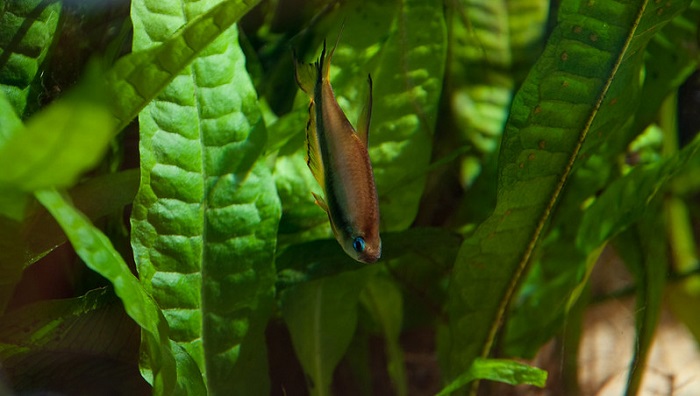
Emperor Tetras are omnivores that enjoy a diet of quality commercial fish food, as well as fresh vegetables, and meat-based foods.
- Pellets And Flakes – Choose a well-balanced high-quality flake or pellet food as a stable to be fed once a day.
- Live And Frozen Foods – Meat-based foods such as Brine Shrimps, Blood Worms, Tubifex Worms, Daphnia, and Mosquito Larvae can be given as a snack for a second meal, especially during spawning.
- Plant Material – You can similarly replace one of their two daily meals with plant matter, or use it as a snack. Spinach, Kale, Zucchini, Lettuce, Carrots, and Cucumbers are ideal, they will need to be blanched and cooled, and shredded into very small pieces.
Feeding your Emperor Tetras twice a day, as much as they can eat within a few minutes is ideal to prevent the build-up of food waste, lest you have some hungry bottom feeders or snails.
Tank Maintenance And Tank Equipment
To keep your Tetra and communal fish healthy, and in good condition, it is vital to practice regular tank maintenance and to keep your ammonia and nitrate levels in your tank at a minimum.
Waste from food, algae, dead plants, and other debris can quickly cause your tank to become dirty and unhealthy. A Good Filtration system and some live plants will help, however, you still need to do regular cleaning.
- A weekly water change of around 25% of the water in your tank is essential, in which case you will need a siphoning hose to drain water from the bottom of the tank and replace it with clean, conditioned, and heated water which you have tested with your testing kit.
- Similarly, you can use an Algae Pad or scraper to remove built-up algae from the sides of your tank, and a Tank Vacuum will come in quite handy for cleaning the substrate and sides of the tank.
- Make sure to remove dead plant matter and leftover foods, before they cause the water in your tank to become soiled. Similarly, decorations that have algae buildup need to be cleaned thoroughly, and your filter will need some cleaning around once a month.
Common Health Issues In Tetras
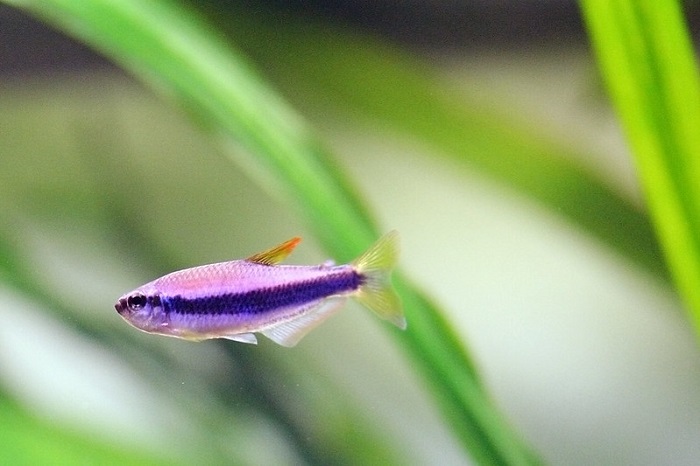
The Emperor Tetra is mostly affected by the usual culprits in Freshwater fish health Issues, and there is no single pest or disease that specifically targets Tetras.
Here are a few of the main health issues affecting freshwater fish in general;
1. Swim Bladder Disease / Dropsy
- Symptoms: Your Fish will struggle to stay in an upright position, it will become lethargic and may float upside down.
- Treatment: Quarantine the fish in a separate and clean tank with good water conditions, and treat them with antibiotics.
- Cause: The condition affects the swim bladder and can be because of fungal or bacterial infection to the swim bladder.
2. Fin Rot
- Symptoms: The fins on your fish will appear ragged and torn with discoloration to the fins and body.
- Treatment: isolating your affected fish in a clean tank, and using an antibacterial medication can help to treat the condition.
- Causes: Fin rot is mainly caused by physical damage, or ammonia burns to the fins, which then results in an infection, caused by poor water conditions.
3. Ich
- Symptoms: There will be small white spots on your fish especially on the fins and near the gills. Your fish may likewise be lethargic and lack appetite.
- Treatment: The condition is contagious and thus all affected fish need to be quarantined in a clean tank. Cycle the water regularly and raise temperatures slightly to end the life cycle of the Parasite which may take around 5 – 7 days.
- Causes: Ich is a condition caused by a Protozoan parasite and the condition becomes worse with poor water parameters. Many times the parasite is introduced with new fish or tank mates that have not been quarantined before adding them to the communal tank.
Breeding
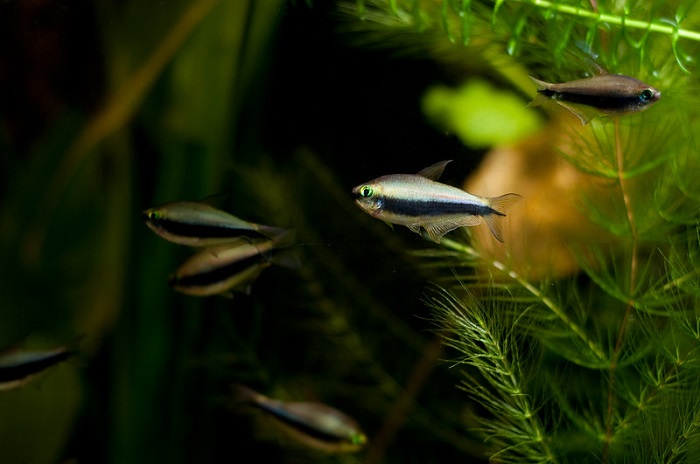
Breeding Emperor Tetra can seem quite simple, though you can only keep a single breeding pair, as males will fight with each other. You will need a separate breeding tank for the eggs and fry as the parents tend to eat the eggs after spawning.
Spawning takes place early in the morning when the female will lay between 50 -100 eggs and the male fertilizes them, after which both need to be removed from the breeding tank.
A breeding tank with plenty of vegetation is necessary for the scattered eggs to attach to, and young fry to hide.
The eggs usually hatch within a day or two, and the young fry will become independent within a few days, where you can start feeding them newly hatched brine shrimp, or infusoria.
Final Thoughts
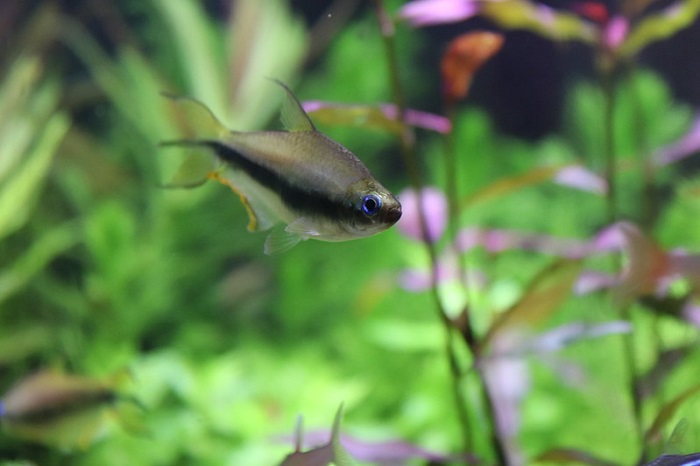
The Emperor Tetra is a spectacular Tetra species that has quite a few striking color variations. They are relatively peaceful and placid fish that can easily be kept in groups however, with a single male only, and they easily get along with many other fish species in a communal tank.
By following our guidelines you should be able to create the perfect environment for your Tetras, keep them healthy and content, and who knows, you may even be blessed with a few young fry.


